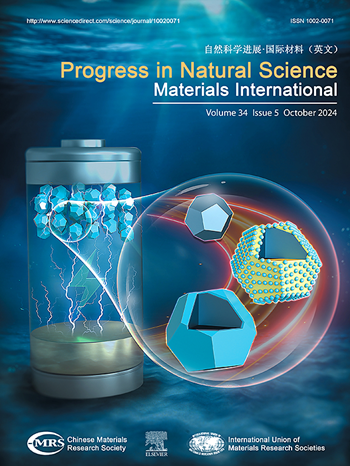富锂和富锰层状正极材料的挑战和潜在解决方案
IF 7.1
2区 材料科学
Q2 MATERIALS SCIENCE, MULTIDISCIPLINARY
Progress in Natural Science: Materials International
Pub Date : 2025-08-01
DOI:10.1016/j.pnsc.2025.06.013
引用次数: 0
摘要
富含锂和锰的层状氧化物(LMRs)具有超过250 mAh g−1的超高可逆容量,是下一代高能锂离子电池的理想正极材料。它们非凡的能力源于六方LiTMO2和单斜Li2MnO3独特的相干纳米结构域,这促进了LMRs具有阴离子和阳离子的混合氧化还原化学。然而,氧阴离子氧化还原过程会导致扩散系数的降低和氧的不可逆释放,由此产生的氧空位会加速过渡金属的迁移。因此,LMR阴极一直面临着速率性能差、初始库仑效率(ICE)低、容量退化和电压衰减严重等四大挑战,严重制约了LMR阴极的大规模应用。在此,本工作将结合文献报道和我们团队近十年的研究成果,简要介绍解决LMRs上述问题的观点。本文章由计算机程序翻译,如有差异,请以英文原文为准。
Insights into the challenges and potential solutions of Li- and Mn-rich layered cathode materials
Li- and Mn-rich layered oxides (LMRs) are a type of ideal cathode material for the next-generation high-energy Li-ion batteries due to their ultrahigh reversible capacity over 250 mAh g−1. Their extraordinary capacity originates from the unique coherent nanodomains of hexagonal LiTMO2 and monoclinic Li2MnO3, which promotes LMRs to have hybrid redox chemistry of anions and cations. However, oxygen anion redox process will induce a decrease in the diffusion coefficient and the irreversible oxygen release, and the resulting oxygen vacancies may accelerate the migration of transition metals. Therefore, the LMR cathodes always suffer from four challenges: poor rate capability, low initial Coulombic efficiency (ICE), substantial capacity degradation and voltage decay, which seriously restrict the large-scale application. Herein, this work will combine with the literature reports and the research results of our team over the past ten years, briefly present the viewpoints on solving the above problems of LMRs.
求助全文
通过发布文献求助,成功后即可免费获取论文全文。
去求助
来源期刊
CiteScore
8.60
自引率
2.10%
发文量
2812
审稿时长
49 days
期刊介绍:
Progress in Natural Science: Materials International provides scientists and engineers throughout the world with a central vehicle for the exchange and dissemination of basic theoretical studies and applied research of advanced materials. The emphasis is placed on original research, both analytical and experimental, which is of permanent interest to engineers and scientists, covering all aspects of new materials and technologies, such as, energy and environmental materials; advanced structural materials; advanced transportation materials, functional and electronic materials; nano-scale and amorphous materials; health and biological materials; materials modeling and simulation; materials characterization; and so on. The latest research achievements and innovative papers in basic theoretical studies and applied research of material science will be carefully selected and promptly reported. Thus, the aim of this Journal is to serve the global materials science and technology community with the latest research findings.
As a service to readers, an international bibliography of recent publications in advanced materials is published bimonthly.

 求助内容:
求助内容: 应助结果提醒方式:
应助结果提醒方式:


